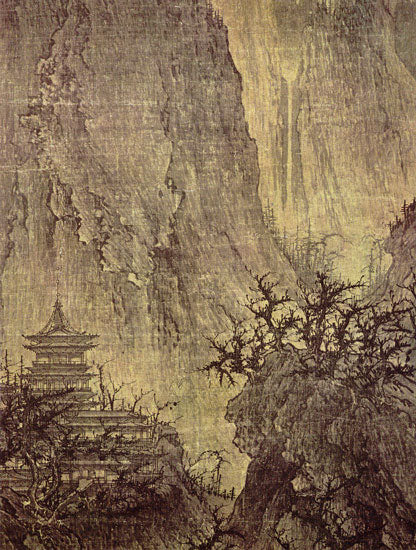Description
The "Buddhist temple in the mountain" of Li Cheng represents, without a doubt, one of the most exquisite examples of Chinese landscape art. Li Cheng, who lived during the Song of the North dynasty (960-1127), is widely recognized for his skills in landscape painting, deeply influencing generations of artists who followed him.
When observing "Buddhist temple in the mountain," one is immediately impressed by the majesty with which nature is represented. The mountain, as the central theme of the work, rises imposing and immense, extending towards the heavens in a spectacular sample of the power of nature. Li Cheng uses the "ink and silkwashing technique" to capture the complexity and texture of the landscape, a method that allows you to combine detail and grandiosity in a single scene.
The Buddhist temple, although small compared to the overwhelming presence of the mountain, stands out for its strategic location and its architectural design. Delically positioned on the hillside, the temple seems like a refuge of serenity and contemplation, almost imperceptible at first sight, but essential in the total composition of the piece. This balance between the human and the natural is a distinctive characteristic of Li Cheng's work, revealing a deep reverence for the landscape as a place of spirituality and reflection.
In the work, the details are rich and complex. Li Cheng uses fine strokes to delineate each tree, rock and structure, giving them almost photographic precision. Through the technique of dry and wet brush, it achieves varied textures that suggest the roughness of the rocks and the softness of the vegetation. It is not only a visual representation, but a sensory evocation of the atmosphere and the terrain.
The colors in "Buddhist temple in the mountain" are sober and monochromatic, as is typical in the paintings ink Chinese. This choice not only highlights Li Cheng's technical ability in the management of ink tones, but also emphasizes the spiritual depth of the scene. The absence of vibrant color directs the viewer's attention to the shapes and shadows, accentuating the pure simplicity and the natural elegance of the environment.
Although there are no visible human characters in painting, an implicit presence can be perceived through the roads and the temple itself. The spectator is invited to imagine himself walking along those paths, ascending to the temple, participating in a spirit with nature.
Li Cheng was a pioneer in the development of the monumental landscape, with influences that endured beyond their time. His contemporaries and subsequent artists revered their work, considering it a perfect synthesis of master technique and spiritual expression. "Buddhist temple in the mountain" is not just a work of art; It is a visual meditation that invites introspection and respect for the immensity and mystery of nature.
In conclusion, this Li Cheng masterpiece is a enduring testament of the classic Chinese landscape. It fuses the meticulous technique with a deep spiritual sensitivity, creating a piece that continues to resonate with power and grace over the centuries. 'Buddhist temple in the mountain' is more than a paint; It is a window to the serenity and majesty of nature and human transcendence within it.
KUADROS ©, a famous paint on your wall.
Hand-made oil painting reproductions, with the quality of professional artists and the distinctive seal of KUADROS ©.
Art reproduction service with satisfaction guarantee. If you are not completely satisfied with the replica of your painting, we refund your money 100%.

